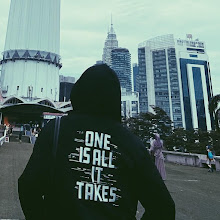The films that fascinate me are those that depend a lot on
stylistics to tell the story. In fact, that’s what films are all about - how a
director tells his stories using the cinematic apparatus. The stylistics used
by a director are pointers as to what a film is really about. In the mise-en-scene are clues scattered
throughout the movies that, when attention is paid to them and their place in
the grand scheme of the director, reveals the background story (as opposed to
the foreground story - the ones we are seeing on the screen). This background
story is what the writer/director really wants to get across - be it about
people, society or the nation at the time the film is made. And when form is
achieved through the stylistics, then what we get is truly - cinema.
Within the poster design of Boo JunFeng’s Apprentice itself are elements that
already tell us about the tragedy that is going to take place in the film.
Aiman (the apprentice executioner) is in silhouette; he is seen from the back
with the interior of the prison and in one-point perspective. All these are
negative indexes. The look is that of a horror movie but this is not a horror
movie. So what is this horror that we are going to witness?
Some clues are in the casting. Casting is about depicting archetypes
- or as in the case of Apprentice -
characters that go against archetype. All the characters in the film - Malay,
Chinese and other inhabitants of Singapore - appear to be a very confused
people. Some (the Malays), are more confused than others. This is shown in a
number of subtle ways: Aiman and his sister, Suhaila are Malays but they look
more like Chinese. Suhaila ‘s voice is more manly while Aiman’s is the
opposite. There is no indication of their Malay identity, either in their
manner or in the decor in the flat that they live in. Suhaila is fed up with
her life and no longer wants to look after their grandparents. The latter’s
complete absence in the story is an indication of how little they figure in the
lives of the brother and sister. Both have abandoned all semblance of their
Malay culture and religion which extol looking after older folk. Suhaila is
fixing to run off to Australia with her boyfriend, John (who is an Indian),
leaving the land of her birth. John is never seen except once and even then, in
the distance. He is also not shown when Aiman stumbles upon him and Suhaila in
the bedroom. He is an non-entity.
Rahim, the master executioner, with his white hair, beard and
moustache is the epitome of a Malay guru of the villages. When he ‘discovers’
Aiman, it is as if he is a guru of ancient days who knows if a student is
capable of study or not. We see him showing Aiman the ropes (no pun intended!);
he is conversant - and concerned - with the way a prisoner dies when hanged.
Death must be instantaneous. That is the humane way for him. He knows which
vertebra of the neck will snap. He knows the correct type and quality of rope
to use. And Aiman, like the archetypal Malay student who has surrendered
himself to the guru, picks up the trade fast, impressing Rahim in the process.
But it is all a sham for both of them. Slowly we begin to find out that it is
all a show as Rahim finds out the truth about Aiman- that his father had been
hanged in that very prison. And Rahim was the hangman! Rahim’s world collapses.
He loses his cool. Gone is the confidence and bravado he had built up over the
years. He bawls out Aiman. He becomes impatient with drivers on the road and
finally speeds and ends up in the ICU after a serious accident. He is no longer
shown in the story and is, obviously in a coma. He, too, ‘ceases to exist’ like
Aiman’s grandparents and John.
The Chinese, on the other hand, have come to accept their
fate. Two Chinese males are to be hanged. Aiman’s visit to one of their
families confirms Rahim’s sham. The mother-in-law tries to prevent Aiman
talking to the condemned man’s wife who is in tears.. The mother and daughter
are seen from outside with the doors grills as if ‘imprisoning’ them. The
mother tells Aiman that he has the wrong house when in fact, it was the right
one. But Rahim lies to the condemned man, saying that it was his father-in-law
who had actually dissuaded her from seeing him for one last time.
The other condemned man has teenage twin sons. As Aiman
rides in a taxi to the prison to hang him, he passes a park where the sons and
friends hold a candle light vigil. They have accepted the situation but are
unable to do anything about it. The system rules. This is quite a long scene and
Aiman is clearly seen to be in confusion. Gone is his original objective of
wanting to help the inmates but now he has been pulled into the system. He is
now the one who actually needs help. Significantly, a Chinese officer who is
next in line to be the hangman withdraws, not having the heart for it. He
cannot take a life.
Setting is another archetype. The interior of the prison is
shot usually looking dark or lit in a manner where it looks sickly. But when
Aiman and Rahim (the executioner) are outside in the city, it is similarly seen
to be dark. Either it is shot at night time (a negative index) or was
colour-graded to be on the dark side. Rides on the MRT are claustrophobically
shot with bars and grills prominent within homes. The lives of people outside the prison are no
better than of those inside. Everyone is a prisoner
Apprentice does
not call for great acting performances from its actors. They just needed to
understand their function in the story. In the hands of director Boo JunFeng,
the actors are akin to props. They just needed to move and behave the way he
wanted them. The rest would be taken care of by the cinematic apparatus. All
were to be in the service of the story. Apprentice
is, surprisingly for its subject matter, a plot-driven story and not a
character-driven one. It is not just about a story that takes place inside a
prison where they execute prisoners on death row. The stylistics speak of the
greater prison that is outside - Singapore itself - where the inhabitants
appear to be also on ‘death row’. They, too, are like props, pawns in a system
who have to behave and live their lives according to something that has been
dictated and over which they have no control.
All that the people can do is to accept their fate and be
slaves to that system. The closest they can get to protest against it is to
light candles and silently pray for salvation. In Eric Khoo’s film, 12 Storyes (1997), the young Meng, an
authoritative and protective brother of a teenage girl, has total faith in the
system and tries to impose it on his wayward sister. The truth hits him really
hard when he can no longer rationalise things according to the system. He
finally loses his mind and is carted off to hospital. The character was
brilliantly played by Koh Boon Pin who plays ASP Joseph, an administrative
officer in Apprentice. In Apprentice, Koh clearly understood his
role. Throughout, he has a tired, expressionless face and looks like a man who
has given up all hope for life.
Twenty years after 12
Storeys, the situation is still the same. The dark and murky opening scene
of an impending execution in Apprentice
is purposely ambiguous. And that visual depiction says it all about life for
the country’s populace and their future. This scene is actually the last scene
in the film. Aiman is now the hangman preparing to carry out his duty. The two
scenes represent a cycle - one that will keep on getting repeated. For the
condemned man, his life ends there and perhaps, the hangman would have sent him
‘to a better place’ (Rahim’s last words to the other man he had hanged). But
for the living, life continues to be a nightmare. It is, in fact, a state much
worse than death...
by : Hassan Abd. Muthalib




















.png)
.png)
.png)
.png)
.png)
0 Ulasan